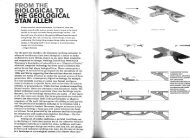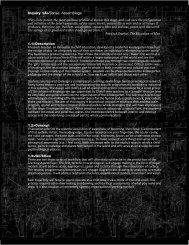Inquiry 1b>Local: Precedent
Inquiry 1b>Local: Precedent
Inquiry 1b>Local: Precedent
You also want an ePaper? Increase the reach of your titles
YUMPU automatically turns print PDFs into web optimized ePapers that Google loves.
<strong>Inquiry</strong> 1b><strong>Local</strong>: <strong>Precedent</strong><br />
1.1>Description<br />
The second part of the first inquiry will involve the research, study, analysis and diagramming of a precedent<br />
Kindergarten. This exercise will be done with your partner from the cinematic research of one Kindergarten<br />
from the list below.<br />
1.2><strong>Precedent</strong> Kindergarten<br />
Europe<br />
Amsterdam’s Children Home. Amsterdam, Holland. Aldo van Eyck. 1955-1960.<br />
Apollo Schools. Amsterdam, Holland. Herman Hertzberger. 1981-1983.<br />
Boarding School. Morella, Spain. Miralles and Pinos. 1986.<br />
Darmstadt School Project. Darmstadt, Germany. Hans Scharoun. 1951.<br />
Dragen Children’s House. Odense, Denmark. C.F. Moller. 2009<br />
Elementary School. Fagnano Olana, Italy. Aldo Rossi. 1972-1976.<br />
‘Els Colors’ Nursery School. Barcelona, Spain. RCR. 2005<br />
Geschwister Scholl. Lunen, Germany. Hans Scharoun. 1958-1962.<br />
Kindertagessatte. Frankfurt Grisheim, Germany. Bolles and Wilson. 1992.<br />
Munkegaards School. Copenhagen, Denmark. Arne Jacobsen. 1956.<br />
Montessori School. Delft, Holland. Herman Hertzberger. 1960-1966.<br />
School at Marl-Drewer. Westphalia, Germany. Hans Scharoun. 1960-1971.<br />
Secondary School. Broni, Italy. Aldo Rossi. 1979.<br />
Americas<br />
Altamira School. Santiago, Chile. Mathias Klotz. 2000.<br />
Corning Child Development Center. Corning, NY. Scogin Elam Bray. 1993.<br />
Diamond Ranch High School. Diamond Bar, CA. Morphosis. 1997.<br />
Head Start School Competition. Reiser Umemoto. 1994.<br />
Long Beach International Elementary School. Long Beach, CA. Thomas Blurock. 2002.<br />
Milwaukee Montessori School. Milwaukee, WI. Studio Works. 1998.<br />
Strawberry Vale Elementary School. Victoria, British Columbia. Patkau Architects. 1994.<br />
Temple Kol Ami Education Center. Scottsdale, Arizona. Will Bruder. 1994.<br />
Asia<br />
Fuji Montessori School (Roof House). Tokyo, Japan. Tezuka Architects. 2007.<br />
Shiroishi Municipal No. 2 Elementary School. Taro Ashihara & Ko Kitayamad. 1996.<br />
1.3><strong>Precedent</strong> Attributes<br />
Following is a list of potential building attributes you may utilize to analyze and diagram the precedent.<br />
1. Programmatic Affiliations<br />
a. play/work/rest zones (classrooms, athletic facilities, library, etc.)<br />
b. relationship of interior to exterior (classrooms to courtyards, etc.)<br />
c. program sequence and adjacency logic<br />
d. surfaces as programmatic organizer<br />
2. Building Site Strategy<br />
a. north/south orientation (direct v. indirect sunlight)<br />
b. orientation to street, neighborhood and site features (accessibility and views)<br />
c. site section/contour logic (hardscape v. softscape)<br />
3. Circulation<br />
a. vehicular and pedestrian<br />
b. hyper-efficiency v. purposeful delay (time based techniques)<br />
c. inside/outside connections<br />
d. public v. private zones (primary v. secondary systems)<br />
4. Structure and Enclosure<br />
a. building assembly system (steel frame, truss, masonry, etc.)<br />
b. modular structural (free plan v. load bearing walls)<br />
c. fenestration (punched openings, panel systems, glazed curtain wall, etc.)<br />
5. Geometry and Morphology<br />
a. typology (courtyard, bar building, atria)<br />
b. solid/void relationships<br />
c. proportional systems (scalar relationships)<br />
d. conceptual analogue (building as artificial landscape, sanctuary)<br />
6. Sensations<br />
a. tactility (smooth zones v. rough zones, intense zones v. calm zones)<br />
b. visual (varied, consistent, expansive, limiting)
1.4>Concepts and Terms<br />
Your diagrams should acquire a key set of terms related to the content being analyzed and should be<br />
annotated as such. These terms should effectively classify or organize the specific content into a larger<br />
conceptual framework with respect to the Kindergarten under consideration.<br />
Furthermore, you should attempt to synthesize those terms and concepts extracted from your cinematic<br />
analysis and diagramming into the diagramming of the precedent. Put another way, can the precedent<br />
Kindergarten a)be analyzed through the lens of your conceptual understanding of your dream sequence<br />
and b)be diagrammed in a manner similar to the way in which you produced the Network Diagrams.<br />
So, a critical question would be: In what way does the precedent behave as a Fluid Network?<br />
1.5>Notation/Diagramming<br />
Consider whether all or part of the notational system you have developed in your Network Diagram may<br />
be useful in diagramming the precedent Kindergarten. Like with the previous diagramming, the intent is<br />
not merely to document information already present in the precedent. But rather to extract the ideas and<br />
concepts at work in the precedent through the notational system of diagramming. You will undoubtedly<br />
utilize found precedent material (plans, sections, etc.) however, like with the dream sequences, these<br />
should added to, modified, abstracted, mutated, etc. to reveal your analytical ideas.<br />
1.6>Deliverables<br />
>(2) 22”x34” boards with a minimum of four diagrams in total<br />
Note: The deliverables should be evenly divided amongst the two members of the group






